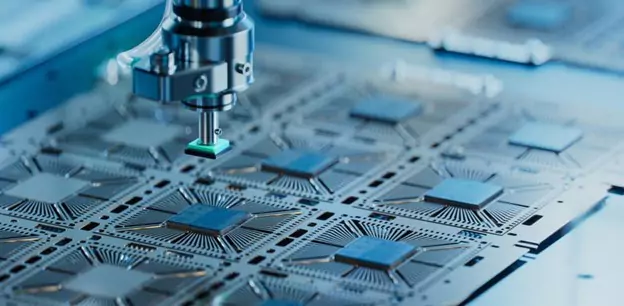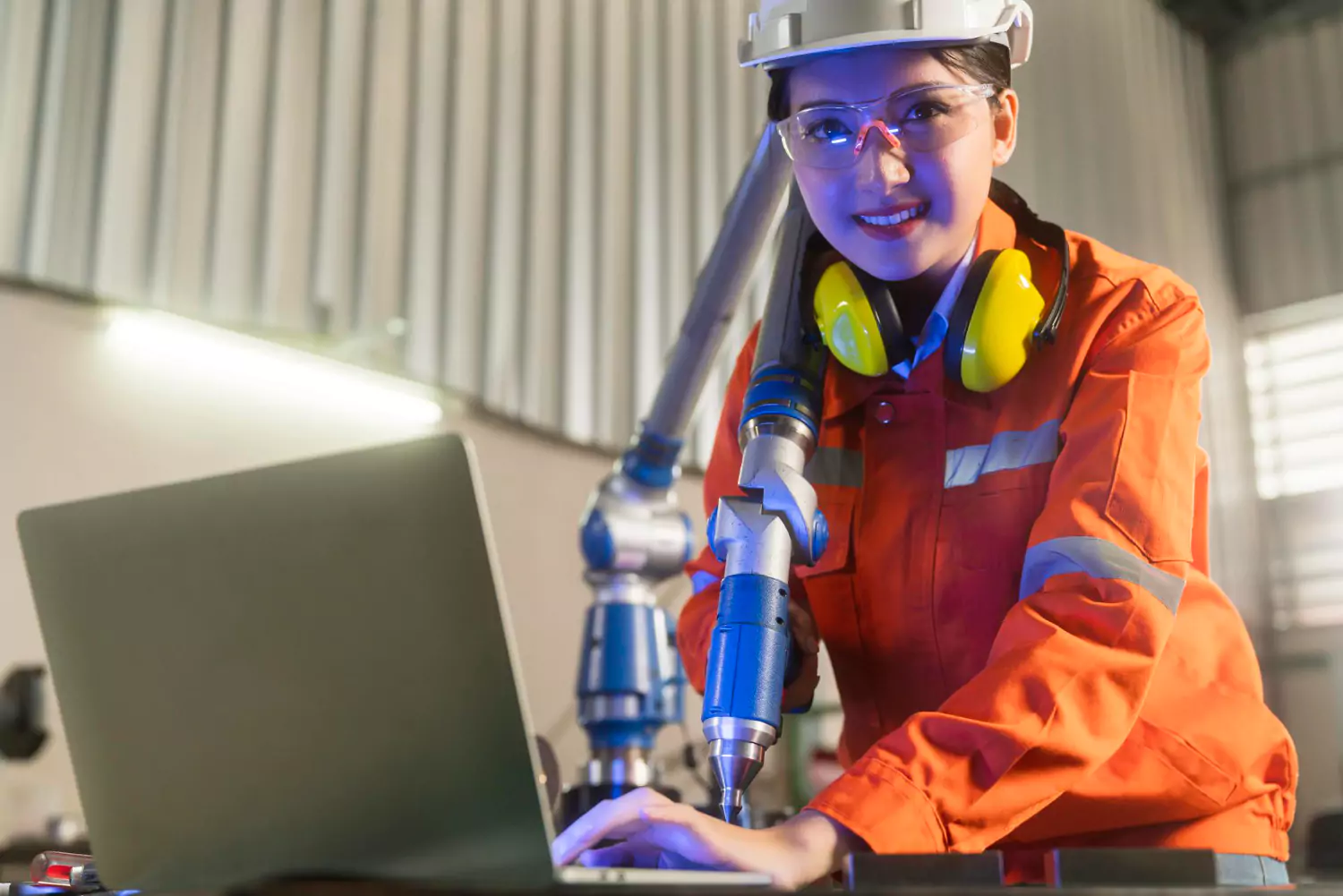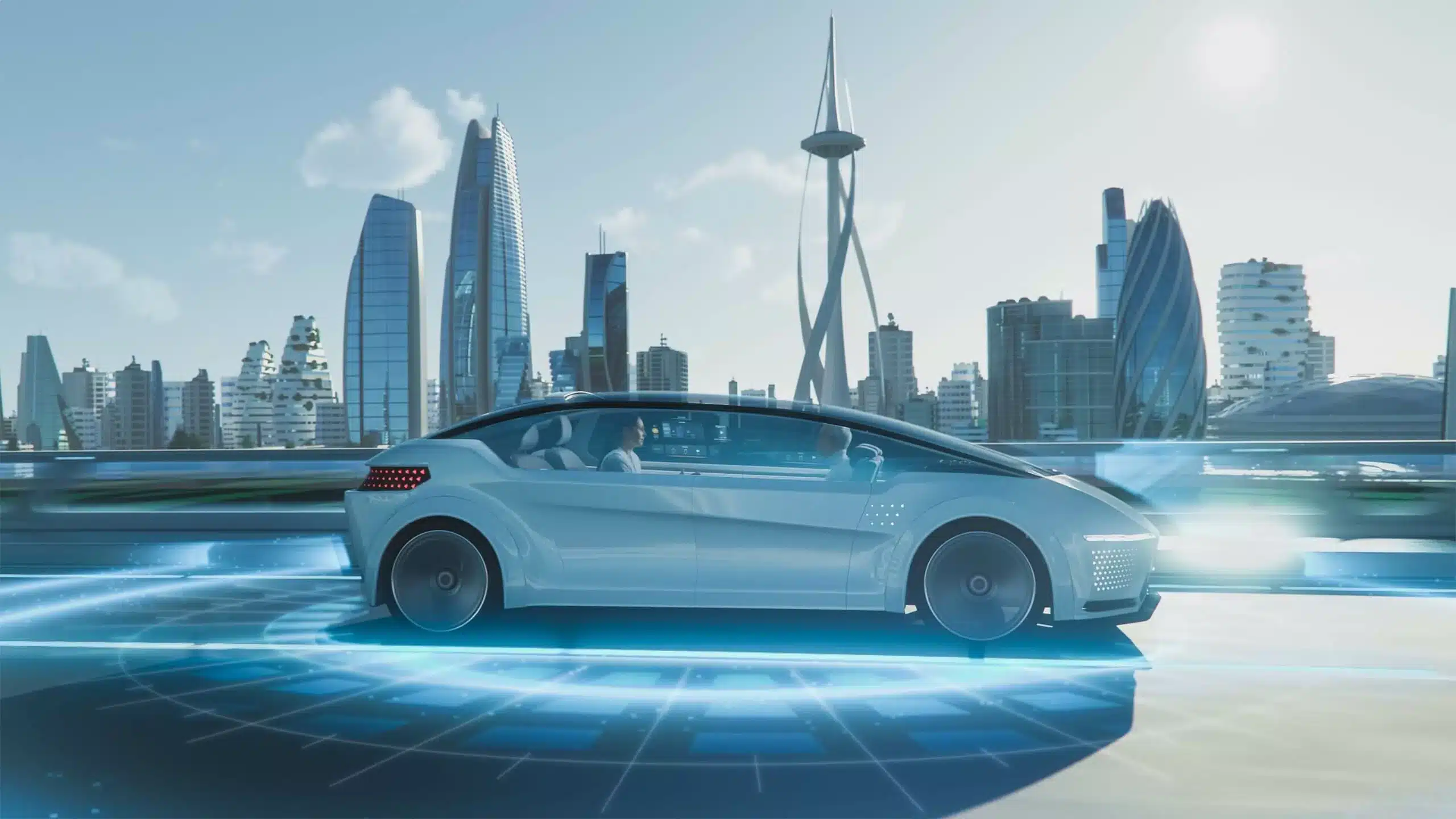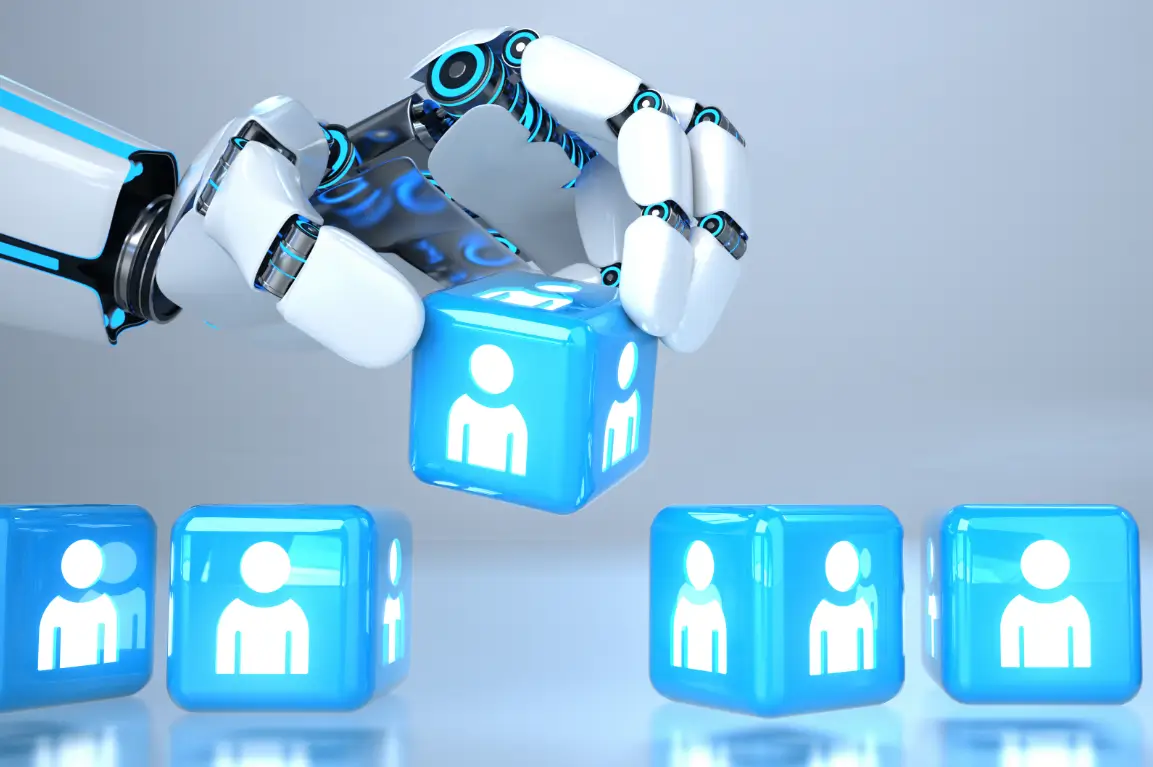ROBOTS: Everything you need to know from myths to mind-blowing technologies and disturbing realities
ROBOTS: Everything you need to know from myths to mind-blowing technologies and disturbing realities
Robots are not what we once thought. They are more than those humanoid creations with odd speech patterns, and they are definitely not as evil as depicted in science-fiction movies like The Terminator (1984) or in novels like Frankenstein’s artificial lifeform monster. Although the now real “killer robots” are making us question whether our subconsciously learned stereotype is really a misconception or rather a prediction of the future, it is safe to say that robots do have many useful applications that benefit society on multiple levels, which is why companies around the world are increasingly opting for them.
So, what exactly are robots?
There are two main types of robots: industrial robots and service robots. Industrial robots are mainly used in manufacturing industries and factories, and they are programmed to handle dangerous tasks that require precision, consistency, and heavy lifting. They represent an important component of process automation, and they are increasingly being integrated with artificial intelligence and the cloud. On the other hand, service robots are often intended for more “soft” tasks in offices, homes, or similar environments to assist people. They can either be human-operated or fully autonomous, and they are safer to interact with since they are designed to be human-facing devices that mimic human abilities. If we look at the numbers, industrial robots generate higher revenues compared to service ones, with USD 24.18 billion for industrial robots compared to USD 8.23 billion for service ones in 2022. Together, both types generated a total of USD 32.41 billion in revenue in 2022 and are expected to reach USD 43.32 billion in 2027, per the below chart.
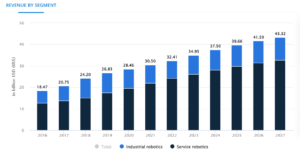
When it comes to industrial robots and the manufacturing industry, Asian countries are dominating the market, with 74% of the 517,385 newly deployed robots in 2021 installed in Asia. In fact, the highest densities of robots can be found in Asian countries, with 932 robots per 10,000 employees in South Korea, compared to 605 in Singapore and 390 in Japan, as shown in the below graph
Manufacturing industry-related robot density in selected countries worldwide in 2020
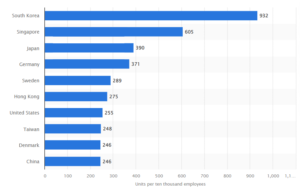
While the Singapore Government is actively seeking to develop national capabilities in robotics through its National Robotics Programme, it has also unexpectedly caused a ramp-up of automation in the country after enacting the “Serious Disasters Punishment Act” in 2021. The new law imposed criminal liability on CEOs and high-ranking managers in the case of injuries and deaths on job sites to encourage them to invest in making workplaces safer; however, in reality, it has pushed companies to avoid the entire problem by replacing workers with machines.
Why the race for robots? Are they really that useful?
Technology has come a long way since the first mechanical invention, an automated water clock, was created in early 270 B.C. While robots were later developed as machines that handle repetitive tasks that do not require precision, they are now deployed across a broad spectrum of industries, with many benefits.
In the healthcare sector, assistive robot arms are opening doors to independence for people with disabilities or advanced muscular problems. Robots are also assisting in hospitals, such as in Mongkutwattana General Hospital in Bangkok, where three robotic nurses helped face the surge in the number of patients in 2017 by traveling between desks and delivering important paperwork and medicine to doctors.
In the retail industry, automation is increasingly incorporated in different stages of the value chain, including logistics and supply chains, back-offices and in-store operations, and sales and marketing, with the aim of optimizing customer experiences and driving revenue. While the global retail automation market was valued at USD 11.3 billion in 2020, it is estimated to reach USD 33 billion in 2030. AI-powered robots such as Effective Retail Intelligent Scanners can take over time-intensive tasks by scanning shelves and alerting staff of any misplaced items and price tag inconsistencies, in addition to issuing stock warnings. In terms of customer support, sensor-based robots can also bring customers the products they are looking for, while AI-powered ones can offer personalized product recommendations.
Moving on to the leisure and travel sectors, we can find that the world’s first AI news anchor joined China’s state-run Xinhua News Agency in 2018 with the ability to mimic facial expressions, speak in both English and Chinese, read texts, and report on social media and on the Xinhua website. Moreover, robots are making life easier and more convenient for humans. For example, during the Tokyo 2020 Games, two Toyota human support robots assisted spectators in wheelchairs by carrying their belongings and guiding them to their seats, while at the Lyon Saint-Exupéry Airport, robot valets are parking cars in a robot-lot, fitting 50 percent more cars in the same area by parking them closer together. Not to mention that a three-armed robot, can now prepare, cut, and serve a pizza in less than five minutes while creating 500,000 unique recipes at the Pazzi restaurant in Paris.

Robots are also extremely helpful in addressing climate change. Advanced technologies are now used to create profitable solutions that positively impact the environment and help achieve net zero goals, in what we call “technology eco-advantage”. PwC UK estimated in 2019 that using environmental applications of AI in four sectors—agriculture, transport, energy, and water—could reduce worldwide greenhouse gas (GHG) emissions by 4% in 2030, the equivalent of 2.4 Gt CO2e. This represents the 2030 annual emissions of Australia, Canada, and Japan combined. Real-life applications that back up this estimation include the tree-planting robot “Growbot”, created by SkyGrow with a mission to plant trees faster than the rate of deforestation. The robot is 10 times faster than trained individuals and helps cut costs in half compared to traditional techniques. Researchers at Sichuan University have also invented a 13-mm-long flexible and self-healing nacre robot fish that is programmed to absorb microplastics from seas and oceans up to 5kg in weight just by swimming around.
If robots are helpful, then why all the controversy?
The truth is, robotic applications are useful for humanity on many different levels, but they rarely come without any serious downsides. Whether it is the displacement effects of robots performing tasks previously done by humans, injuries caused by over-automation, or ethical concerns about killer robots and algorithmic bias, many questions are being raised about what the future holds and how much we can control.
Displacement effects and the concept of “Reshoring”
A study on the US labor market found that for every robot added per 1,000 workers in the U.S., wages would decline by 0.42%, and one robot would decrease employment by 3.3 workers. This displacement effect varies based on the gender, age, and country of the worker. In fact, the World Economic Forum found in 2019 that women are more likely to lose their jobs due to automation in comparison to men because the positions that have more than a 90% chance of becoming automated, such as cashiers, administrative assistants, and bookkeepers, are mostly dominated by women. Accordingly, for every seven men employed in occupations with a 90 percent likelihood of automation, there are 10 women. The IMF also estimated in 2018 that 26 million women in 30 countries face a high risk of being displaced by technology within the next 20 years.
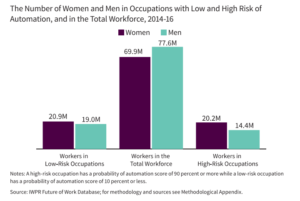
When it comes to age, young people aged 16-24 face the highest vulnerability to losing their jobs compared to other age groups, as shown in the below graph. As for country-level effects, the ILO has also raised the idea of “reshoring”, where labor-intensive tasks previously outsourced to developing countries can be reshored to developed ones to be performed by robots, resulting in a shift in the global division of labor.
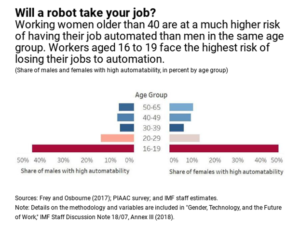
Injuries and inefficiencies
It is true that robots are more efficient than humans in certain aspects, but overusing them can be dangerous. For example, after Amazon began employing robots in its warehouses in 2014 to take on repetitive tasks, the Center for Investigative Reporting revealed in 2020 that during the period 2016-2019, the rate of serious injuries endured by Amazon employees at automated warehouses was 50 percent higher than at facilities that didn’t use robots. This was due to robots increasing workers’ quotas from scanning 100 items per hour to scanning 400, which was far beyond their human capacity.
While over-automation might not always lead to injuries, it can often be inefficient. In Japan, after the Henn na Hotel opened in 2015 as the first hotel in the world to be entirely staffed by robots, it had to replace more than half of its 243 robotic workforce with traditional human service providers in 2019. Robots were found to annoy guests and break down many times; they were incapable of answering some basic questions at the front desk, and robot room assistants woke up guests in the middle of the night as they mistook snoring sounds for commands. Despite these risks, robot hotels are increasingly becoming popular worldwide, with NEOM’s first robot-powered Yotel Hotel opening in the Oxagon district in 2025, in Saudi Arabia.
Algorithmic bias and toxic stereotypes
Another major concern that shakes our trust in robots is their programming, which is based on biased artificial intelligence algorithms. In 2022, in a collaboration between Johns Hopkins University and other educational institutions, scientists asked programmed robots to scan blocks with people’s faces on them and choose a block based on their command. When asked to select a “criminal block”, the robot chose the block with the black man’s face 10% more often than when asked to select a “person block”. Also, when asked to select a “janitor block” the robot selected Latino men 10% more often while selecting men more often than women when asked for a “doctor block” and choosing black and Latina women when asked for a “homemaker block”. On another note, in May 2016, the investigative journalism organization ProPublica claimed that the Correctional Offender Management Profiling for Alternative Sanctions (COMPAS), a computer program used by a US court for risk assessment, was found to mistakenly label black defendants as more likely to re-offend at almost twice the rate as white people. Similar COMPAS and programs are used in hundreds of courts across the US, making us question if robots are being racialized as “white” and programmed with toxic stereotypes.
Legal autonomous weapons and killer robots
Ethical concerns take a much bigger turn when it comes to lethal autonomous weapons and military robots that use artificial intelligence to identify and kill human targets without human intervention. These are no longer limited to movies but are becoming a reality on the battlefield.

A military combat robot experiment developed by the U.S. military’s research labs
Source: Teslarati
While some see it as more ethical to employ robots in wars rather than human fighters, others think that “killer robots” can cause more collateral damage than human soldiers. They have been designed to be unpredictable to be one step ahead of the enemy, but their unpredictability combined with their speed, lack of situational awareness, risk of inaccurate target identification, and programming based on biometric information can rapidly escalate the conflict and result in selective killing based on age, gender, and race. Once these weapons start being mass-produced, they can be sold on the black market and fall into the wrong hands, leading to human disasters.
How are organizations, companies, and employees reacting?
The United Nations Convention on Certain Conventional Weapons (CCW) in Geneva started discussing lethal autonomous weapons in 2013 and set up in 2016 a Group of Governmental Experts (GGE) to develop a new ‘normative and operational framework’ for member states. In July 2015, during a joint conference on artificial intelligence, an open letter calling for a ban on autonomous weapons was released and signed by significant figures such as Elon Musk, inventor and founder of Tesla, Steve Wozniak, co-founder of Apple, and Stephen Hawking, physicist at the University of Columbia. Also, the Stop Killer Robots Coalition, formed by Human Rights Watch, Amnesty International, and other NGOs, was launched in 2013 to call for new international law on autonomy in weapons systems, and in October 2022, 70 states delivered a joint statement on autonomous weapons systems in what became the largest cross-regional group statement ever made throughout UN discussions on the issue so far.
When it comes to industrial and service robots, many employees perceive robots as the new “digital workforce” that is stealing their jobs. While denying the truth is pointless, companies should try to openly communicate with their workers their vision for the future in terms of automation and technology and invest in training and upskilling their employees to be able to fit in an automated workplace where robots complement employees’ work rather than replace them.
So… Are we for or against robots?
Robots might be able to perform some of the same tasks as humans with higher speed and accuracy, but they still have a long way to go when it comes to emotional and cultural sensitivity, opening doors to questions, concerns, and fears. It is almost like a love-hate relationship, but it is also one with which we eventually need to make peace if we want to stay ahead of the game. New robotic technologies, or even bots and chatbots like ChatGPT, will never stop breaking new ground, and it is up to us to determine how we perceive them. Allies or enemies? The choice is yours.
Author: Mané Djizmedjian
Sources:
https://www.sciencefriday.com/segments/the-origin-of-the-word-robot/
https://www.bcg.com/publications/2014/business-unit-strategy-innovation-rise-of-robotics
https://www.thoughtco.com/timeline-of-robots-1992363
https://www.geeksforgeeks.org/differences-between-industrial-robots-and-service-robots/
https://www.statista.com/outlook/tmo/robotics/worldwide#revenue
https://www.automation.com/en-us/articles/october-2022/ifr-presents-world-robotics-report-2022
https://restofworld.org/2022/korea-factories-replace-humans-with-robots/
https://www.cnbc.com/2018/11/09/the-worlds-first-ai-news-anchor-has-gone-live-in-china.html
https://news.yahoo.com/hospital-uses-robots-instead-nurses-130000636.html
https://sg.news.yahoo.com/2019-03-15-stanley-robotics-robot-valets-airport-france.html
https://worldcrunch.com/tech-science/how-five-countries-are-integrating-robots-into-daily-life
https://www.bcg.com/publications/2021/how-technology-helps-sustainability-initiatives
https://www.pwc.com/gx/en/news-room/press-releases/2019/ai-realise-gains-environment.html
https://www.statista.com/statistics/1257213/retail-automation-market-size/
https://www.wired.com/story/amazons-worker-injury-problem/
https://www.adaptarobotics.com/robots/eris/
https://www.wevolver.com/article/how-ai-powered-robots-are-transforming-the-retail-industry
https://www.hotelmanagement.net/tech/japan-s-henn-na-hotel-fires-half-its-robot-workforce
https://www.revfine.com/robots-hospitality-industry/
https://www.weforum.org/agenda/2019/03/women-face-greater-threat-from-job-automation-than-men
https://hbr.org/2017/04/the-countries-most-and-least-likely-to-be-affected-by-automation
https://www.ilo.org/wcmsp5/groups/public/—ed_emp/documents/publication/wcms_751599.pdf
https://www.abilities.com/community/buzz/64b-jaco.html
https://www.bcg.com/publications/2014/business-unit-strategy-innovation-rise-of-robotics
https://autonomousweapons.org/
https://www.washingtonpost.com/technology/2022/07/16/racist-robots-ai/
https://dl.acm.org/doi/pdf/10.1145/3531146.3533138
https://www.fastcompany.com/90212508/even-black-robots-are-impacted-by-racism
https://www.teslarati.com/ai-weapons-darpa-kaist-south-korea-boycott/
https://nexxis.com/overcoming-staff-resistance-to-working-with-robots/



